How to Create Compelling B2B Blog Posts That Build Audiences and Convert Customers
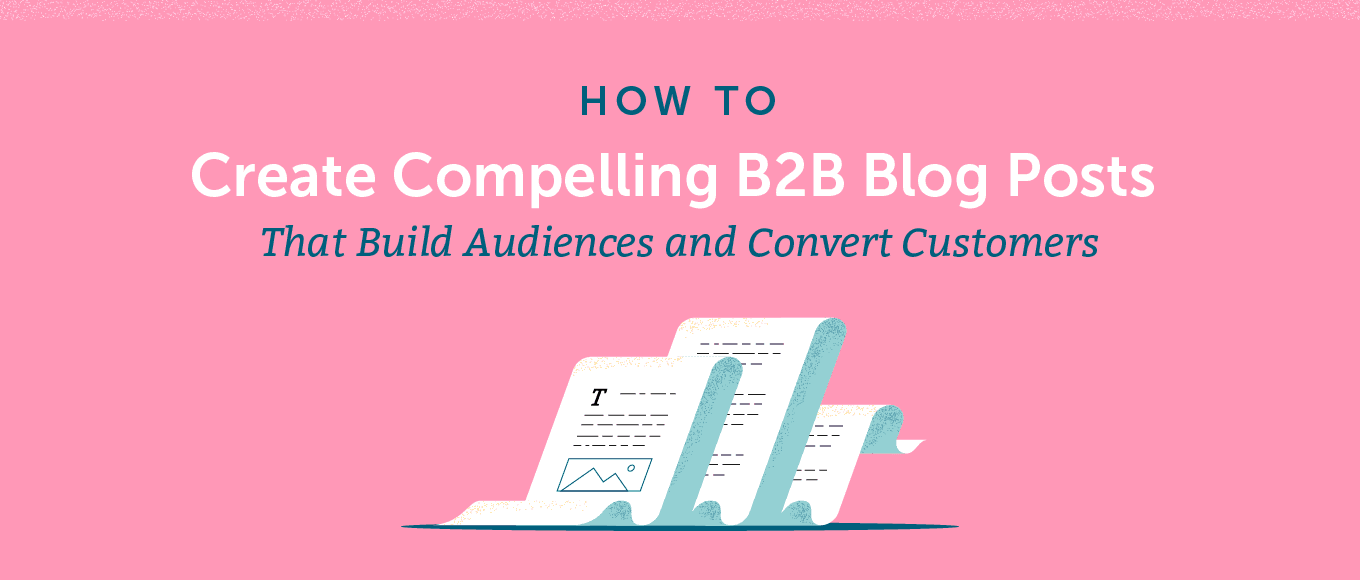 The idea that B2B blog posts have to be serious and highly technical is a misconception. Yes, B2B audiences want expert advice and lots of it. But, blog posts don't need to be convoluted.
Nowadays, it’s more important for B2B audiences to see quality and value in your content.
You’re no doubt aware of the vast amount of content you have to compete with. If your content isn’t of the highest quality, we’re talking Beyoncé levels of greatness, then it will disappear into obscurity like the five other former members of Destiny’s Child.
So, the conundrum here is...
How do you meet the needs of an intelligent and demanding audience? But, at the same time, keep them interested with the kind of stuff they actually want to see and read?
The idea that B2B blog posts have to be serious and highly technical is a misconception. Yes, B2B audiences want expert advice and lots of it. But, blog posts don't need to be convoluted.
Nowadays, it’s more important for B2B audiences to see quality and value in your content.
You’re no doubt aware of the vast amount of content you have to compete with. If your content isn’t of the highest quality, we’re talking Beyoncé levels of greatness, then it will disappear into obscurity like the five other former members of Destiny’s Child.
So, the conundrum here is...
How do you meet the needs of an intelligent and demanding audience? But, at the same time, keep them interested with the kind of stuff they actually want to see and read?
Schedule Your B2B Content With This Calendar Template
Great content often starts with a plan, and content plans are best organized on a calendar. Visualize your B2B content publishing schedule and never miss a deadline again with this calendar template:The Value Of Blogging For B2B Companies
Blog content should be a crucial part of any company’s marketing strategy. There are a number of reasons why: traffic and SEO, increasing brand awareness, growing your email subscriber list and so on. But what is the value of blogging for B2B companies specifically? Well, it all comes down to the way in which B2B audiences work. When B2B buyers make a purchase there’s a lot more research and more people involved, thus making the time it takes to make a purchase longer. Research from Adobe revealed that 90% of B2B customers take twists and turns throughout the buying journey, even repeating steps. The point is that the B2B customer journey is complex. Any way that you can make the journey easier will ultimately benefit your business. So, to some extent, the value of B2B blog content lies in sharing useful information with customers to make their overall journey easier. What’s more, 96% of the most successful B2B content marketers say that content builds trust and credibility with their audience. B2B audiences are super smart. It’s much better to build trust with your audience over time through educational blog posts than to make some bold sales pitch, which they will see right through. In fact, an Isoline study showed that over half of B2B buyers consume 3-5 pieces of content before contacting a supplier: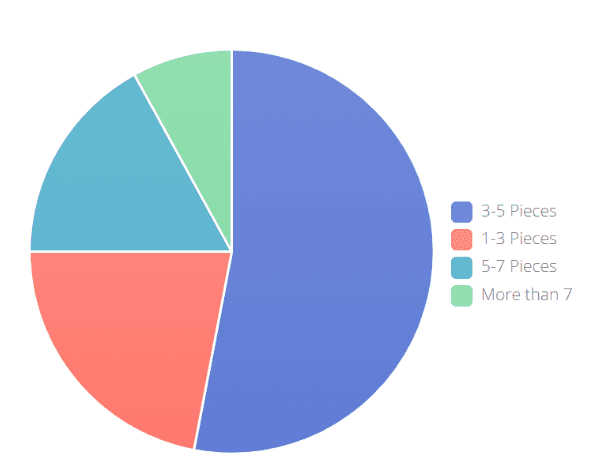 This proves that content isn’t just valuable, it’s a necessary part of the buyer’s journey. And you can use it to share helpful information and earn the customer’s favor and trust throughout.
This proves that content isn’t just valuable, it’s a necessary part of the buyer’s journey. And you can use it to share helpful information and earn the customer’s favor and trust throughout.
How to Create Compelling B2B Blog Posts That Build Audiences and Convert Customers
Click To TweetB2B Vs. B2C Blog Posts: What Are The Differences?
B2B and B2C blog posts are sisters, not twins. If you want to create content for a B2B audience specifically, then it helps to understand the key differences between B2B and B2C blog posts. Here are the main characteristics worth noting when writing for B2B vs. B2C audiences:B2C Content
- Example types of content: a listicle, influencer interview, editorial piece or simple how-to.
- The tone is casual, fun. B2C posts use straightforward and relatable language.
- Posts are shorter in length. B2C audiences want an efficient experience. The goal is to drive the consumer to a quick, or even an impulse, purchase decision. While the goal for B2B content is to build long-term relationships.
- Content is emotionally-driven. B2C buyers make purchases based on their emotions, as opposed to the more careful, logical approach of B2B buyers. So, B2C content needs to be striking and memorable.
- It’s also product-driven. You see lots of flashy images of products. The intention is to grab the consumer’s attention in the moment. That’s also why the subject matter is often what’s on-trend, rather than an evergreen topic.
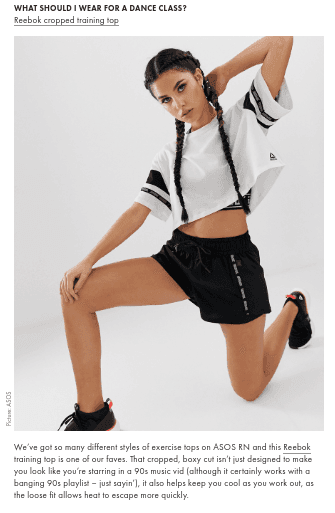 Note the cool, casual language, the fact that it’s all about the product, and the evocative content. Which 90s baby doesn’t want to look like the star of a 90s music video, after all?
Note the cool, casual language, the fact that it’s all about the product, and the evocative content. Which 90s baby doesn’t want to look like the star of a 90s music video, after all?
B2B Content
- Example types of content: a case study, white paper, thought leadership post, or an in-depth guide.
- The tone is more serious. Complex topics call for more complex descriptions. Your audience should understand the terminology you use, though you don’t need to use jargon for jargon’s sake. Nor does the tone have to be dry and boring just because it’s B2B.
- Posts are highly-detailed. They’re likely to be longer and more detailed as B2B audiences are sponges for information.
- Content is data-driven. Intelligent B2B audiences want to see hard proof of what you’re telling them. This aids in the decision-making process.
- Posts are more likely to be educational/informational. B2B content is more subtle in the way it convinces prospects of the benefits of a product or service. There’s a greater emphasis on sharing useful, expert knowledge.
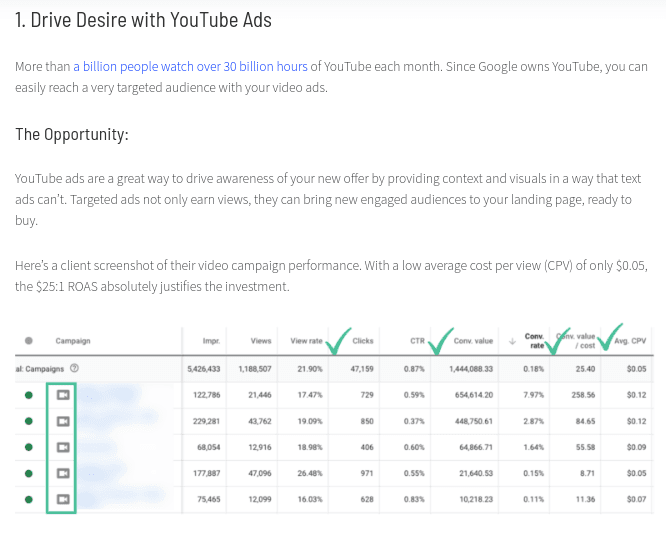 You can clearly see the high level of detail, abundant use of data and educational slant.
You can clearly see the high level of detail, abundant use of data and educational slant.
B2B content tip: make an abundant use of data. Get more tips like this here:
Click To TweetWhat Do B2B Audiences Expect From Content?
There has been a shift in B2B content marketing towards customer-centric content. You need to produce the content that they desire. This means throwing out content based on traditional keyword research or your sales pitch. Instead, you should be creating content based on real questions your audience ask and their intent. Here’s how to create more customer-centric content based on what audiences expect from your brand:1. Speak to Them Personally
B2B audiences expect to see content catered specifically to them. This shouldn’t be too difficult to achieve. While B2C audiences might be made up of varying personas, as a B2B brand, you have more of a niche segment to speak to. If you can understand their interests and desires, it’s easier to make content more personal and really speak to them.2. Show Off Your Value
One thing B2B audiences really care about is ROI. So, you need to emphasize the importance of your product or service, even if you don’t explicitly state it. Obviously, this is important for those in the awareness stage of the buyer’s journey. But you also need to go beyond this stage and create content for existing customers to show them how to get the most value from your product.3. Educate Them
Educational content helps in the decision-making process. B2B audiences want solutions to their problems. You get to make their lives or their jobs easier through the content you create. Consider how and why somebody came to your content (their intent), and give them something they can apply successfully in real-life. This is why B2B content must have a strong level of depth and expertise.4. Engage Them
B2B audiences want compelling content as much as B2C audiences. That’s something that will never change across the board. The difference is what they find interesting or compelling. Essentially, you need to give your audience something that they want to read and that they can easily digest. Again, it helps to know what the user expects to see, in terms of information and format, i.e. what they’re familiar with. And it never hurts to provide some entertainment value, which we’ll get onto later…
How To Find B2B Blog Post Ideas
Now that you understand the importance of customer-centric content, just how do you come up with blog post ideas that your audience will love?1. Answer Audience Questions
Provide solutions to customer pain points by finding questions that your target audience is asking. There are a few great sources where you can find such questions:- Google’s People Also Ask Box - Here you can find endless queries related to a topic. For example, when you type in “what is cloud computing”, you get a list of queries like this:

- AnswerThePublic - This site collects queries that are auto-suggested by search engines.
- Forums/Quora/Reddit - Find forums related to your niche or search your topics on sites such as Quora or Reddit to find a goldmine of user questions.
2. Consider Intent
Think about what kind of solution somebody is looking for when they ask a question and what stage they’re at in the buyer’s journey. Different kinds of content will be more effective in different cases. Here’s a useful table from Brainrider to assist you: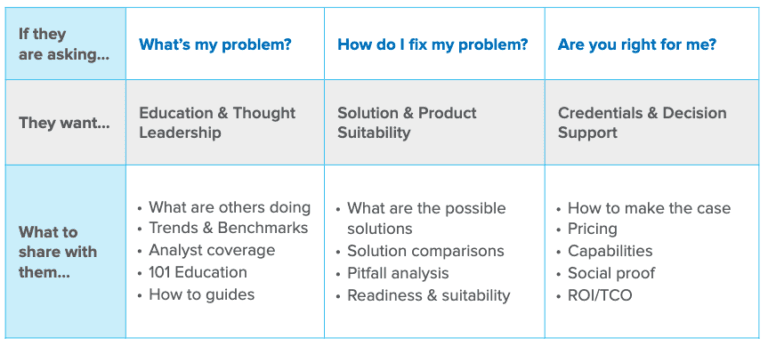 Source
Source
3. Choose High-Performing Topics
Head to Google Analytics to discover your top-performing posts. You’ll find them under Behavior > Site Content > All Pages: This shows which topics your audience is most interested in. You can then cover them from a different angle or dig deeper into a certain sub-topic.
Alternatively, there are numerous tools you can use to find topics that are popular across the web. BuzzSumo, for instance, displays popular blog posts according to social media engagement:
This shows which topics your audience is most interested in. You can then cover them from a different angle or dig deeper into a certain sub-topic.
Alternatively, there are numerous tools you can use to find topics that are popular across the web. BuzzSumo, for instance, displays popular blog posts according to social media engagement:
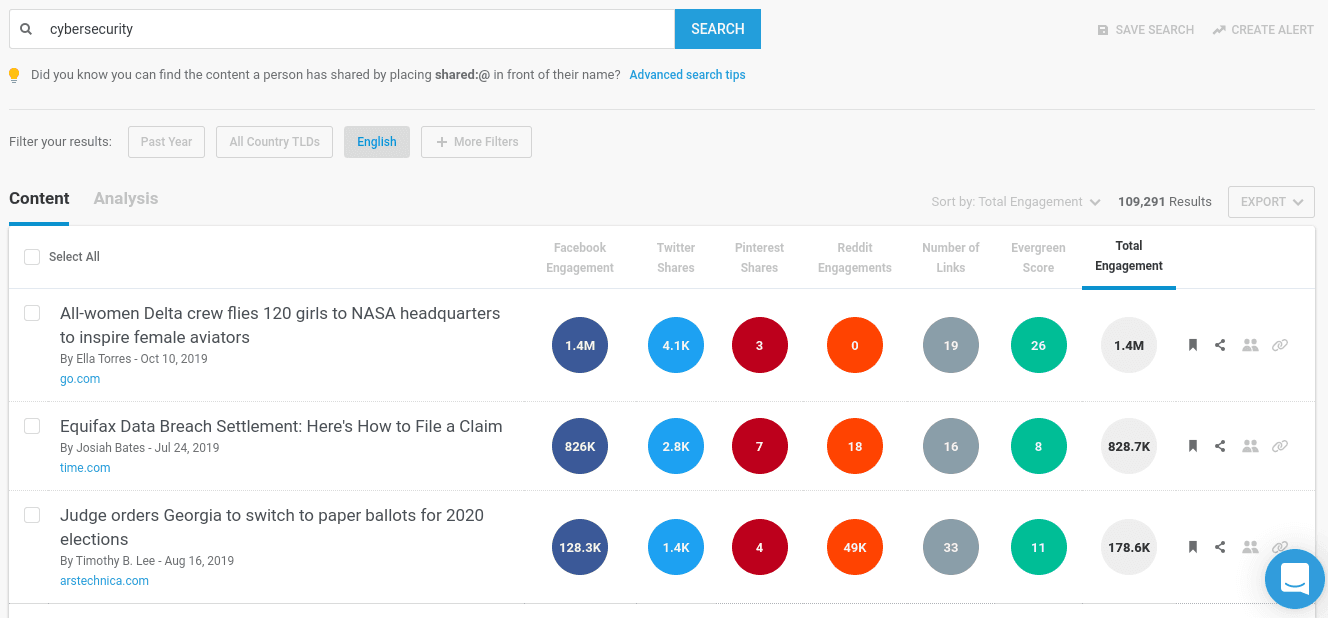 Essentially, it’s all about putting your audience’s interests and informational needs first.
Essentially, it’s all about putting your audience’s interests and informational needs first.
How To Write Compelling B2B Headlines
Compelling headlines encourage more people to click through and read your posts, whether that’s on social media or search engines. Generic headlines get lost in the sea of content that’s out there. You may wish to use proven headline formulas based on research. A BuzzSumo study showed that top-performing B2B blog posts contained the following phrases:- “The Future of”
- “How to Use”
- “Need to”
- “How to Create”
- “Here’s How”
- “You Need to Know”
 Let’s break this headline down into its key parts:
Let’s break this headline down into its key parts:
- “How to Create” - This is the familiar element.
- “a Powerful Chatbot” - The word “powerful” evokes emotion.
- “in 15 minutes” - This is a power phrase that incites action in the reader.
How To Make Your Posts Data-Driven
When something is ‘compelling’, it’s interesting, irrefutable, convincing. Data can represent all of these things, which is why it’s so useful in B2B content. A data-driven blog post can be directly related to your product or service, as in a case study, for example. You can and should also publish data that reveals something interesting about your industry, as in original research or an original study. You can collect and collate data from other credible sources to create unique posts. And use this data to back up arguments within all of your content. Visual representations of data are particularly compelling as they can demonstrate aspects such as comparisons and change over time. Plus, they stick in the mind of the reader. Graphics are an essential element of quality content.How To Create Expert, Authoritative Content
B2B audiences require expert content because of the types of subject matter involved. They’re looking for a solution to a problem. So, if they’re going to take advice from a piece of content and invest time or money when they apply it in real life, they need to know it’s solid advice that they can trust. This notion has been reflected in Google’s algorithm updates of recent years, in particular, the 2018 Medic update and June 2019 broad core algorithm update. Rankings were affected where sites required expertise, including a decent chunk of sites related to business or finance: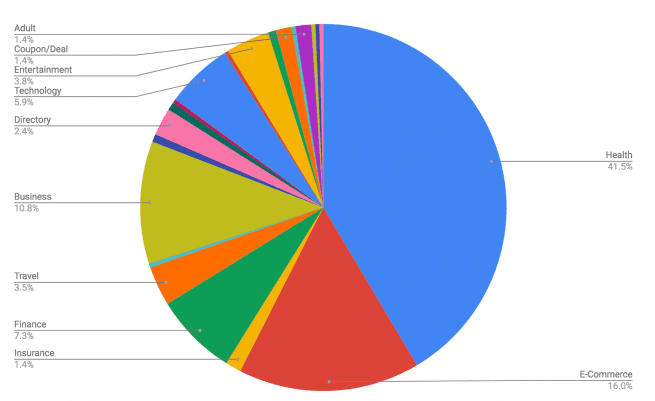 The point is, it’s more important than ever to create content that displays expertise and authoritativeness.
To do this, again, you need to focus on creating in-depth, quality content that’s backed by evidence and catered to your audience’s needs. But also, you should build the credibility of your authors and site as a whole.
Check your authority for free using MozBar. You’ll see a domain authority rating and spam score like so:
The point is, it’s more important than ever to create content that displays expertise and authoritativeness.
To do this, again, you need to focus on creating in-depth, quality content that’s backed by evidence and catered to your audience’s needs. But also, you should build the credibility of your authors and site as a whole.
Check your authority for free using MozBar. You’ll see a domain authority rating and spam score like so:
 Naturally, you’ll want to work on increasing your authority and reducing your spam score.
Naturally, you’ll want to work on increasing your authority and reducing your spam score.
How To Keep Scanners On The Page
A blog post made up of just a wall of text is going to turn people off. Some people will read every word of your blog post, but many will simply scan the post for the information they require. So, if your text isn’t easy-to-digest then they will bounce. An easy-to-read format includes:- A clear structure with text broken up by headers, images, bulleted/numbered lists etc.
- A table of contents.
- A logical structure that flows and makes sense.
- Short paragraphs and sentences that keep users engaged and moving through your text.
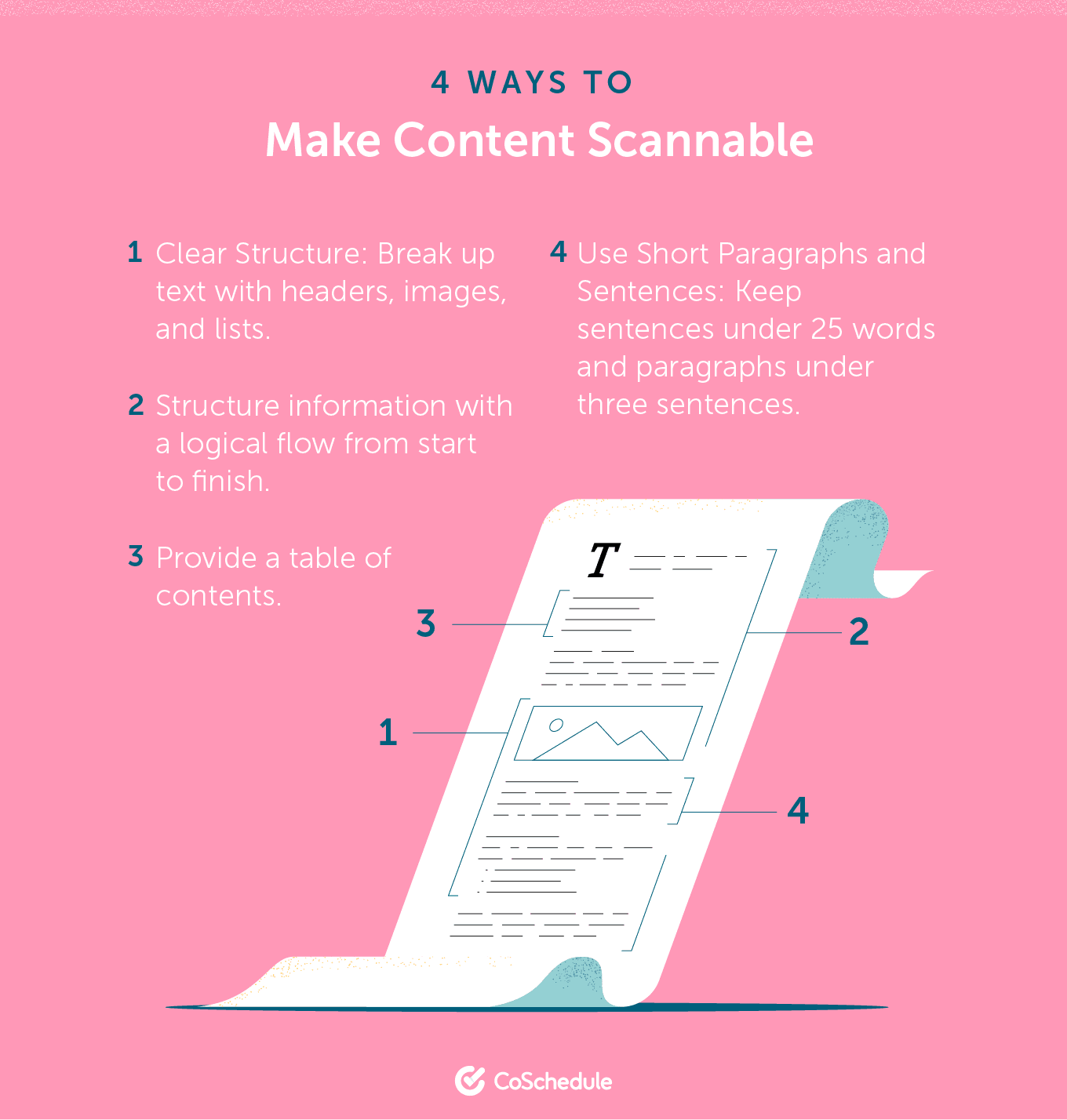 Elements like these that make your content more readable are good for user experience.
Elements like these that make your content more readable are good for user experience.
Ways to Make B2B Content More Engaging
Many B2B blog posts are drier than a mouth full of crackers. Depending on your branding, you may not want a tone that’s quite as casual as the average B2C post. However, you still need your audience to actually want to read and enjoy your posts, while they’re learning something. This will keep them on the page and help build a long-term relationship with customers. Along with many of the above points, you’ll also want to do the following to make your b2b blog posts more engaging:1. Inject Personality
Your brand voice helps you portray your brand identity and characteristics. You don’t even necessarily need a conversational tone of voice, simply one that’s uniquely yours. For instance, is your brand super transparent and honest? Then you’ll want to make sure your content contains genuine opinions. Or perhaps you want your brand to seem friendly? Then you’ll have to rid your content of any negative slants2. Use Humor
No one is expecting you to have the comedic talent of Wanda Sykes. But, humor is an easy way to make your content less boring. So, throw in the odd joke or cultural reference. And if you can use humor intelligently or make it about your industry, this will appeal to a B2B audience even more.3. Utilize Storytelling
Nowadays, B2B audiences are especially aware of how the marketing machine works. Therefore, they want to see an authentic, human touch in your content. Storytelling also gives you the opportunity to demonstrate the value of your product or service in the real world.7 Examples Of Compelling B2B Blog Posts
Here are some examples of compelling B2B content that you can use for inspo:1. “How to Get Rid of a Virus & Other Malware on Your Computer” - AVG
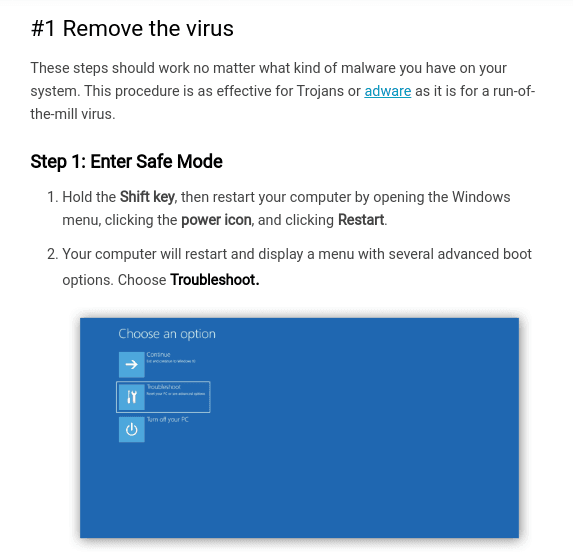 What Makes It Compelling?
This is a great example of in-depth educational content. It’s an actionable guide that takes readers through a step-by-step process, using screenshots to illustrate. It also anticipates user needs by directing Mac users to a guide specifically for them.
What Makes It Compelling?
This is a great example of in-depth educational content. It’s an actionable guide that takes readers through a step-by-step process, using screenshots to illustrate. It also anticipates user needs by directing Mac users to a guide specifically for them.
2. “Cloud Computing Trends: 2019 State of the Cloud Survey” - Flexera
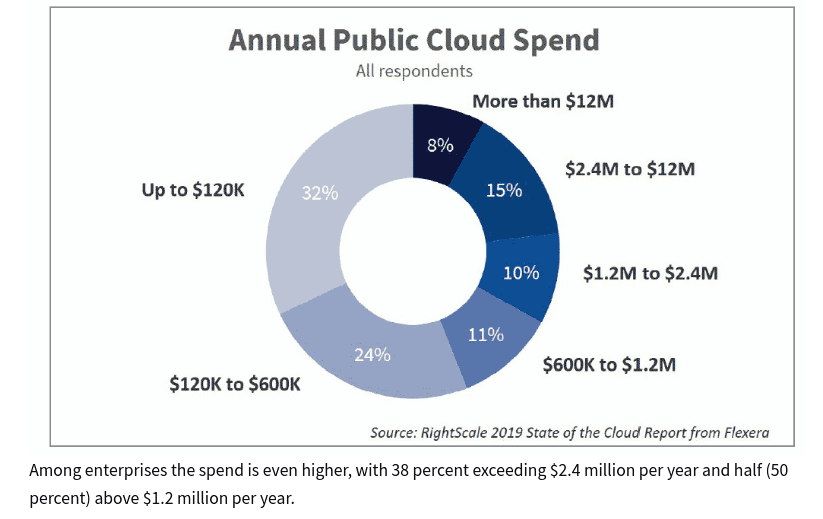 What Makes It Compelling?
For this original study, Flexera surveyed over 786 IT professionals, over half of which represented enterprises with more than 1,000 employees. So, this is an example of unique and thorough data-driven content.
The report has a highlights section suitable for scanners, plus visual representations of their results - what more could you expect?
What Makes It Compelling?
For this original study, Flexera surveyed over 786 IT professionals, over half of which represented enterprises with more than 1,000 employees. So, this is an example of unique and thorough data-driven content.
The report has a highlights section suitable for scanners, plus visual representations of their results - what more could you expect?
3. “A Huge List of Places to Find Freelance Photography Jobs (Updated!)” - FreshBooks
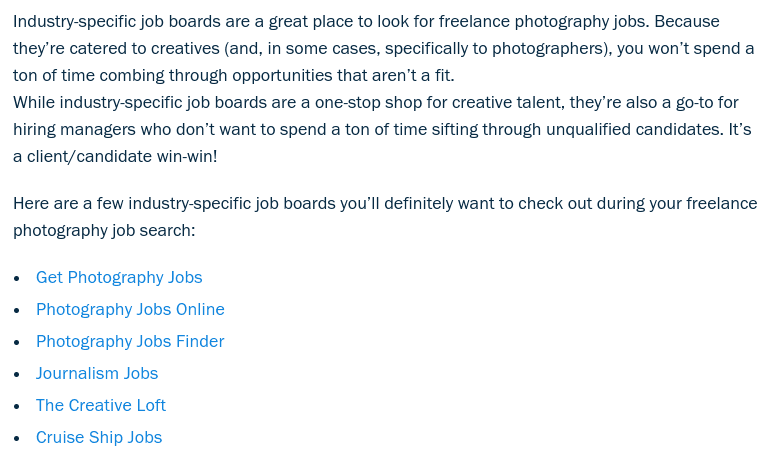 What Makes It Compelling?
This post represents audience-centric content, as it provides useful information as well as valuable resources for the reader.
It solves a key pain point for this audience segment, i.e. “where can I find freelance photography jobs?” What’s more, they clearly update their content regularly to retain its value.
What Makes It Compelling?
This post represents audience-centric content, as it provides useful information as well as valuable resources for the reader.
It solves a key pain point for this audience segment, i.e. “where can I find freelance photography jobs?” What’s more, they clearly update their content regularly to retain its value.
4. The Content Strategist - Contently
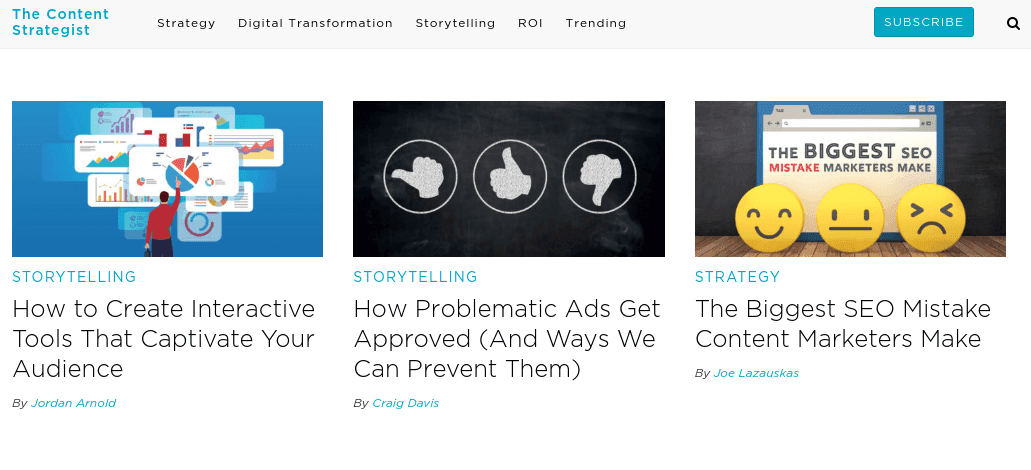 What Makes It Compelling?
To ensure that their content really speaks to their audience personally, Contently has two separate blogs - the above example for content marketers and another for freelancers. This is an intelligent means of personalizing a content marketing strategy.
What Makes It Compelling?
To ensure that their content really speaks to their audience personally, Contently has two separate blogs - the above example for content marketers and another for freelancers. This is an intelligent means of personalizing a content marketing strategy.
5. “Patient-centered care and technology: a powerful partnership” - Philips
 What Makes It Compelling?
Here we have a thought leadership piece that oozes expertise and authority. For starters, the author is named as a “Nuclear Medicine Physician and Neuroradiologist”. *Ahem*
Not only does she incorporate storytelling by sharing her own experiences as an expert, but she also makes use of data and discusses the future of the industry.
What Makes It Compelling?
Here we have a thought leadership piece that oozes expertise and authority. For starters, the author is named as a “Nuclear Medicine Physician and Neuroradiologist”. *Ahem*
Not only does she incorporate storytelling by sharing her own experiences as an expert, but she also makes use of data and discusses the future of the industry.
6. “Open-ended questions vs. close-ended questions: examples and how to survey users” - Hotjar
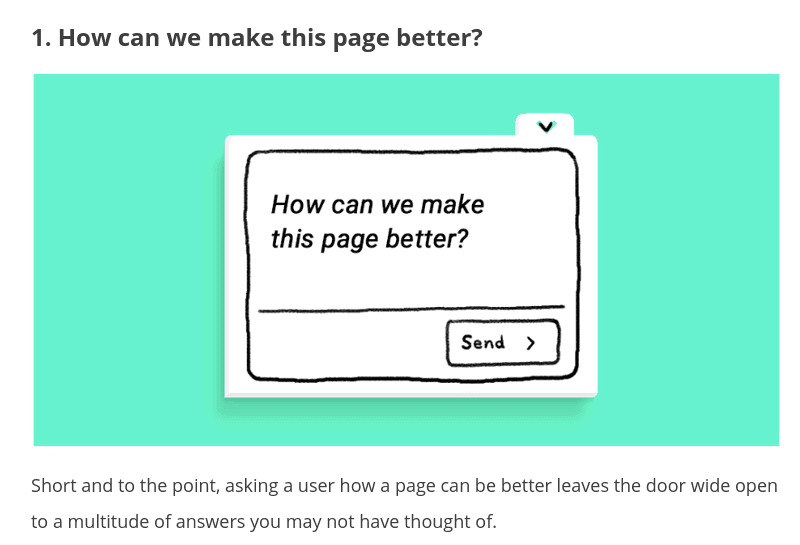 What Makes It Compelling?
This post epitomizes great blog design. There’s a clear and logical structure, which is necessary for a complex topic such as this.
Also worth noting, is that Hotjar uses original graphics in this post, as well as many of their other posts. This makes their posts memorable, useful and enjoyable.
What Makes It Compelling?
This post epitomizes great blog design. There’s a clear and logical structure, which is necessary for a complex topic such as this.
Also worth noting, is that Hotjar uses original graphics in this post, as well as many of their other posts. This makes their posts memorable, useful and enjoyable.
7. “6 Customer Experience Trends That Will Determine Your CX Success (Or Failure) In 2020” - Drift
 What Makes It Compelling?
This post contains so many elements of a great B2B blog post. It’s in-depth, it’s actionable, it’s data-driven. But what makes it even better is the use of personality. The tone is intelligent but conversational and the author has a good sense of humor.
Now you’ve seen some examples of what B2B blog content should look like. The trick is to take away aspects that make sense for your brand and emulate them.
What Makes It Compelling?
This post contains so many elements of a great B2B blog post. It’s in-depth, it’s actionable, it’s data-driven. But what makes it even better is the use of personality. The tone is intelligent but conversational and the author has a good sense of humor.
Now you’ve seen some examples of what B2B blog content should look like. The trick is to take away aspects that make sense for your brand and emulate them.


